Belarus Tour Guide: Ideas for Your Trip!
What to see in Nesvizh: A UNESCO World Heritage site and many other attractions
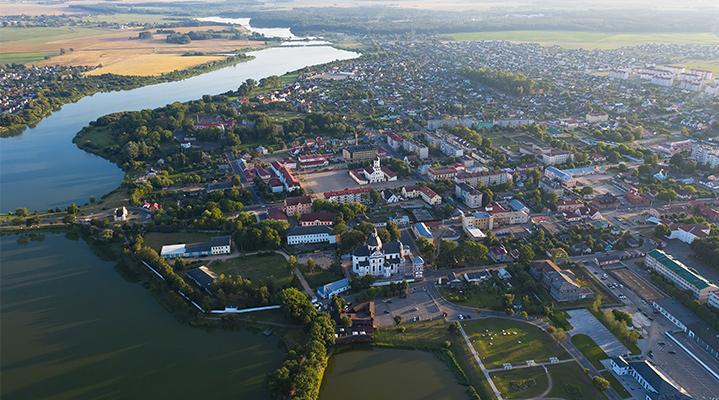
The legendary Nesvizh is worth seeing just for its magnificent 16th-century palace: a UNESCO World Heritage site, a former residence of the Radziwills, one of Europe's largest and most powerful families. At the end of the 20th century, the palace and other surviving attractions of the town in the south-west of Minsk Oblast received a wide-ranging protected status – the National Historical and Cultural Museum-Reserve “Nesvizh”. Today it is one of the country’s most visited places, a must see for every resident and visitor to Belarus.
Nesvizh Palace
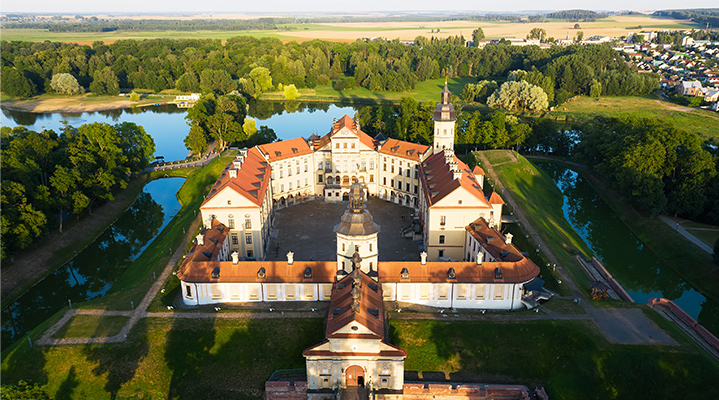 Nesvizh Castle, Nesvizh Palace, Architectural, Residential and Cultural Complex of the Radziwill Family at Nesvizh… The famous residence goes by different names. Throughout its history it served both as an impregnable castle ready to repel any attack, and as a luxurious palace, a thing of admiration and envy of contemporaries.
Nesvizh Castle, Nesvizh Palace, Architectural, Residential and Cultural Complex of the Radziwill Family at Nesvizh… The famous residence goes by different names. Throughout its history it served both as an impregnable castle ready to repel any attack, and as a luxurious palace, a thing of admiration and envy of contemporaries.
Until the second half of the 16th century, there was a wooden castle in Nesvizh owned by the Kiszka family. The Radziwills, one of the most powerful families of the Grand Duchy of Lithuania, acquired Nesvizh as the dowry of Jan Radziwill’s wife Princess Anna from the Kiszka family whom he wed in 1533... This legendary family owned the town for more than four centuries!
In 1582, Prince Mikolaj Krzysztof Radziwill the Orphan ordered to build a stone castle, which became one of the most beautiful residences in Europe. It is believed that the castle was designed by Italian architect Giovanni Maria Bernardoni. However, the evidence says that the architect joined the project in Nesvizh only in the summer of 1586 while the construction started earlier. A number of researchers believe that the initial architect could have been from France, or that the drawings were prepared by architects from the court of King Stephen Bathory. Bernardoni was involved in the interior design of the palace.
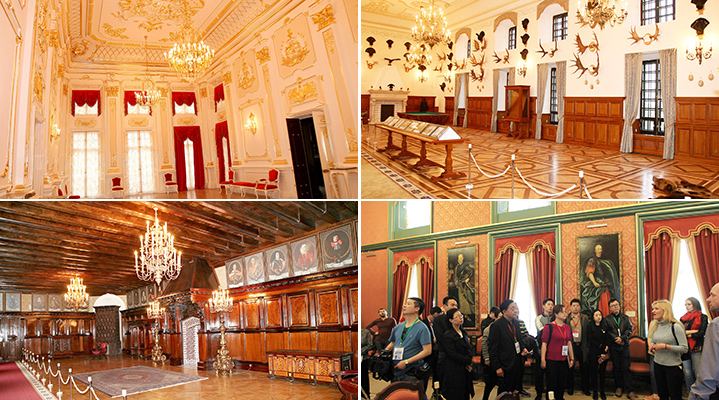 In the 16th-19th centuries, the palace-castle ensemble was rebuilt more than once. Today it is a blend of different styles: medieval architecture, late Renaissance, Baroque, Classicism, and original ideas of local masters. It was the richest aristocratic and cultural center of its time. In the second half of the 18th century the palace was known for the largest private library in Rzeczpospolita, the art gallery of about a thousand canvases, rare valuables, and unique collections of weapons and numismatics. Talented representatives of the Radziwill family contributed to the fame of Nesvizh. For example, they took part in theatrical performances, alongside serf actors, in Nesvizh Court Theater, which was a highly acclaimed company in 1740-1791. Princess Francesca Ursula Radziwill became the first female writer and playwright in Rzeczpospolita.
In the 16th-19th centuries, the palace-castle ensemble was rebuilt more than once. Today it is a blend of different styles: medieval architecture, late Renaissance, Baroque, Classicism, and original ideas of local masters. It was the richest aristocratic and cultural center of its time. In the second half of the 18th century the palace was known for the largest private library in Rzeczpospolita, the art gallery of about a thousand canvases, rare valuables, and unique collections of weapons and numismatics. Talented representatives of the Radziwill family contributed to the fame of Nesvizh. For example, they took part in theatrical performances, alongside serf actors, in Nesvizh Court Theater, which was a highly acclaimed company in 1740-1791. Princess Francesca Ursula Radziwill became the first female writer and playwright in Rzeczpospolita.
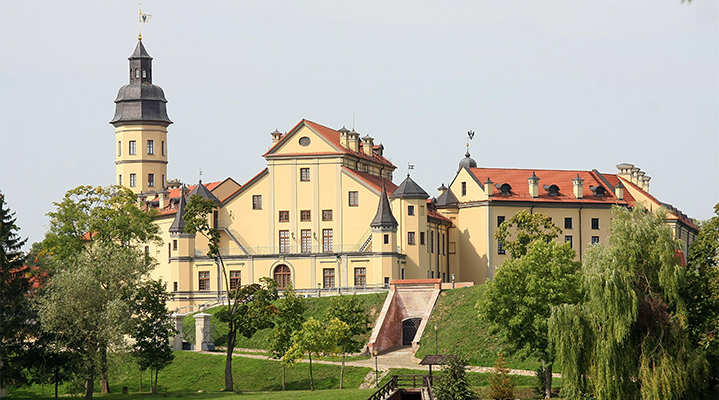 The Radziwills left the town in 1939 when the Red Army entered Nesvizh and Soviet power was established. Since then, it has been under the protection of the state. During the Soviet time the residence lost its former glory. The palace was used as a sanatorium and came to complete desolation by the end of the 20th century. Awarding it the status of a museum-reserve marked a new stage in the life of the princely residence.
The Radziwills left the town in 1939 when the Red Army entered Nesvizh and Soviet power was established. Since then, it has been under the protection of the state. During the Soviet time the residence lost its former glory. The palace was used as a sanatorium and came to complete desolation by the end of the 20th century. Awarding it the status of a museum-reserve marked a new stage in the life of the princely residence.
The palace completed the most extensive restoration of modern times in 2012. Today this gem, a UNESCO World Heritage site, is open to the public. The palace hosts excursions, interactive quests, and various events. Once a year, the residence hosts the country’s favorite art project “The Evenings of the Bolshoi Theater at the Radziwill Castle”.
Palace Parks of Nesvizh
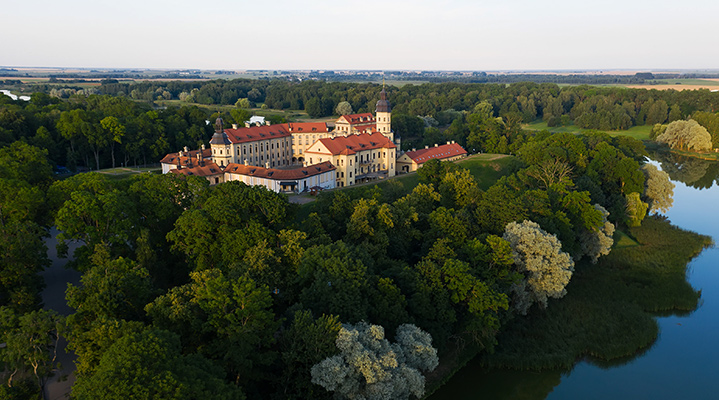 The Radziwill Palace is surrounded by magnificent old parks. They were laid out after the residence was built. Small green areas were planted in the times of Prince Mikolaj Krzysztof Radziwill the Orphan and Michal Kazimierz Rybenko. Most of the planting was conducted under Princess Maria Dorota Radziwill, a member of the house of Castellane. In 1865, when she first arrived, the place was a sad sight. “Not a single tree. Total desertedness. Just two old pear trees, probably used to mark the former borders, and over a hundred small grey shacks of the locals were the rare objects to lay eyes on...” The work on the park began in the 1870s: seedlings were brought from nurseries, flower beds were laid on the castle ramparts, terraces and arbors were set up.
The Radziwill Palace is surrounded by magnificent old parks. They were laid out after the residence was built. Small green areas were planted in the times of Prince Mikolaj Krzysztof Radziwill the Orphan and Michal Kazimierz Rybenko. Most of the planting was conducted under Princess Maria Dorota Radziwill, a member of the house of Castellane. In 1865, when she first arrived, the place was a sad sight. “Not a single tree. Total desertedness. Just two old pear trees, probably used to mark the former borders, and over a hundred small grey shacks of the locals were the rare objects to lay eyes on...” The work on the park began in the 1870s: seedlings were brought from nurseries, flower beds were laid on the castle ramparts, terraces and arbors were set up.
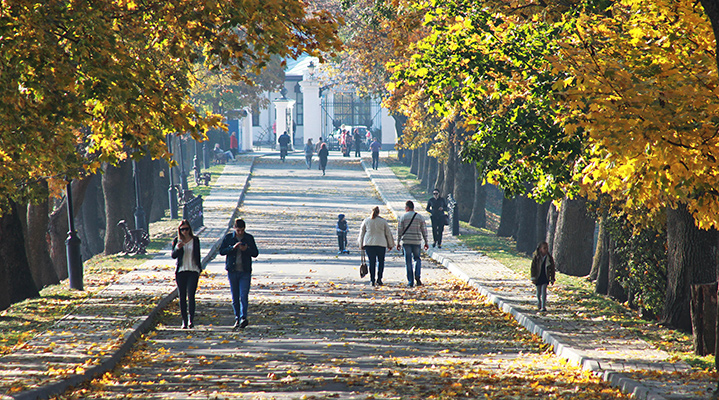 Today the Nesvizh Palace has five parks that were planted at different times – Castle, Old, Japanese, English and New or Marysin. They stretch along the banks of the palace ponds called as Bernardine’s, Castle and Wild. Each park has its own charm and special places. For example, Old Park, at the time of its founding, had only one Canadian poplar 28 meter high. The tree stood till the early 21st century but was uprooted by a storm in the spring of 2005. A sculptural composition has been erected in its place. Another symbol of the park is the memorial stone, which the Prince erected in honor of his beloved: “... In recognition of many years of work to decorate the castle by Maria de Castellane, Princess Radziwill, this stone was placed in 1903 by her grateful husband Prince Anthony Radziwill, XIV Ordinate of Nesvizh.”
Today the Nesvizh Palace has five parks that were planted at different times – Castle, Old, Japanese, English and New or Marysin. They stretch along the banks of the palace ponds called as Bernardine’s, Castle and Wild. Each park has its own charm and special places. For example, Old Park, at the time of its founding, had only one Canadian poplar 28 meter high. The tree stood till the early 21st century but was uprooted by a storm in the spring of 2005. A sculptural composition has been erected in its place. Another symbol of the park is the memorial stone, which the Prince erected in honor of his beloved: “... In recognition of many years of work to decorate the castle by Maria de Castellane, Princess Radziwill, this stone was placed in 1903 by her grateful husband Prince Anthony Radziwill, XIV Ordinate of Nesvizh.”
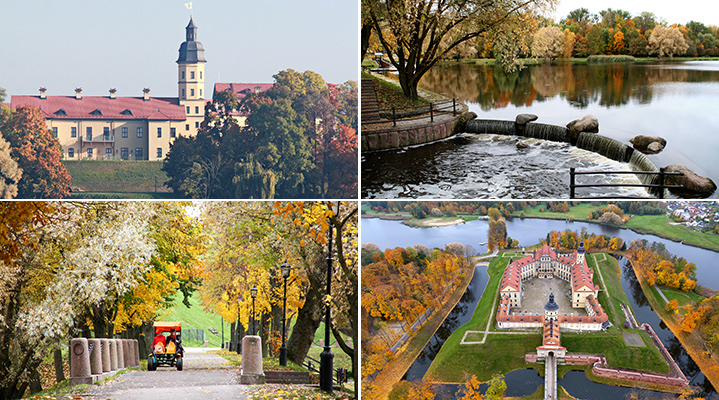 Old Park, with a summerhouse, a tennis court, and the Exhibition Glade, was the owners' favorite recreation site. Lately, it has been decorated with sculptures such as the monument to the dog that saved the hunting prince from the bear; Musician and Angel inspired by Yakub Kolas’ poem Simon the Musician; Black Lady in honor of Princess Barbara Radziwill and the most mystical story of the Nesvizh Palace; and Mermaid. There is also Mermaid’s Well and Humpback Bridge in the park. An Alley of Memory was founded in 1992. The alley features busts of outstanding people who went down in the history of the town: Princes Yuri Nesvizhsky and Prince Mikolaj Krzysztof Radziwill the Orphan”, engraving artist Tomasz Makowski, architect Giovanni Maria Bernardoni, poets Wladyslaw Syrokomla and Yakub Kolas.
Old Park, with a summerhouse, a tennis court, and the Exhibition Glade, was the owners' favorite recreation site. Lately, it has been decorated with sculptures such as the monument to the dog that saved the hunting prince from the bear; Musician and Angel inspired by Yakub Kolas’ poem Simon the Musician; Black Lady in honor of Princess Barbara Radziwill and the most mystical story of the Nesvizh Palace; and Mermaid. There is also Mermaid’s Well and Humpback Bridge in the park. An Alley of Memory was founded in 1992. The alley features busts of outstanding people who went down in the history of the town: Princes Yuri Nesvizhsky and Prince Mikolaj Krzysztof Radziwill the Orphan”, engraving artist Tomasz Makowski, architect Giovanni Maria Bernardoni, poets Wladyslaw Syrokomla and Yakub Kolas.
In Old Park, where a bloody battle took place during the Great Patriotic War, there is a monument to Nesvizh Jews. On 30 October 1941, the Nazis shot 1,500 residents of the town and its surroundings. Old men, women and children – dead and wounded – were thrown into a ditch and buried. In the post-war years, the remains of those people were reburied at the town cemetery.
Japanese Park was set up in 1913-1914. According to the plan, it was to become an exotic Oriental corner featuring twisting paths, dwarf trees and stone compositions. This idea, however, never materialized and today the park looks almost the same as the others.
English and New Parks lie on the opposite bank from the residence. The border between them goes along a road leading to the palace rampart. New Park is the biggest one in the Nesvizh ensemble. It is also called Marysin. Among the things that survived there to the present day there is an obelisk to honor the groundbreaking ceremony of the park with a sign reading “Marysin 1898” and a beautiful legend about the love of Princess Radziwill to a poor nobleman. By the way, trees in English Park were planted in a chessboard order.
Monument to the Heroes of the Great Patriotic War
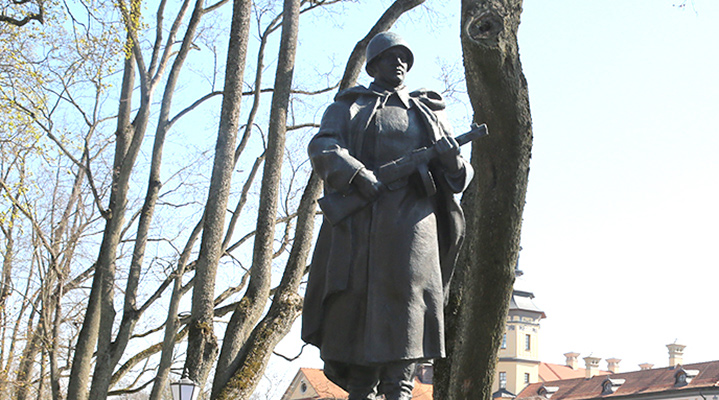 The monument to the Heroes of the Great Patriotic War is located near the palace. The monument highlights the link between generations. It stands close to the western bastion, over the mass grave of the Soviet soldiers who died liberating Nesvizh at the beginning of July 1944. During the occupation, in 1941-1944, the palace was home to a military hospital.
The monument to the Heroes of the Great Patriotic War is located near the palace. The monument highlights the link between generations. It stands close to the western bastion, over the mass grave of the Soviet soldiers who died liberating Nesvizh at the beginning of July 1944. During the occupation, in 1941-1944, the palace was home to a military hospital.
Corpus Christi Church
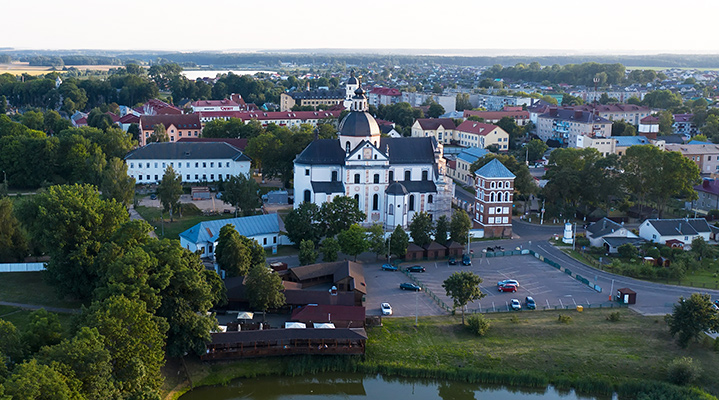 The church, commissioned by Prince Mikolaj Krzysztof Radziwill the Orphan was built by Giovanni Maria Bernardoni near the palace in 1587-1593. The church in Nesvizh became the first baroque structure in the Polish-Lithuanian Commonwealth and one the most beautiful baroque churches in Europe, distinguished by the frescoes both inside the building and on the exterior walls.
The church, commissioned by Prince Mikolaj Krzysztof Radziwill the Orphan was built by Giovanni Maria Bernardoni near the palace in 1587-1593. The church in Nesvizh became the first baroque structure in the Polish-Lithuanian Commonwealth and one the most beautiful baroque churches in Europe, distinguished by the frescoes both inside the building and on the exterior walls.
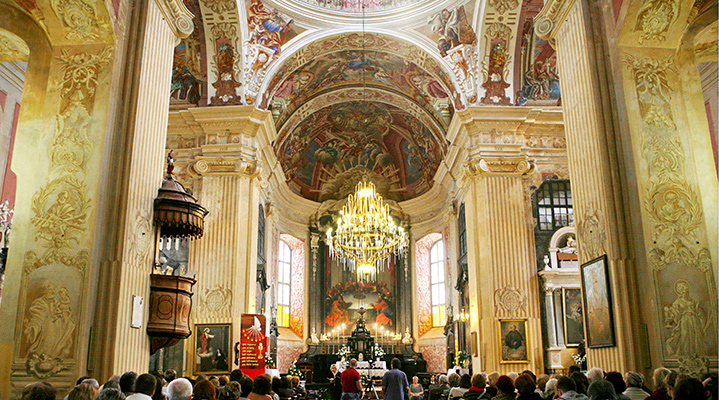 Most of the frescoes were created in the 1750s-1760s by court artists of the Radziwills. The main altar is decorated with The Last Supper painting by K.D. Gessky (1752). Moreover, the interior design of the church featured a lot of reliefs and busts on the 17th-19th-century tombstones, marble altars, and monuments. The choir with an organ towers above the entrance. The crypt of the church is home to the Radziwill family vault with about 70 tombs.
Most of the frescoes were created in the 1750s-1760s by court artists of the Radziwills. The main altar is decorated with The Last Supper painting by K.D. Gessky (1752). Moreover, the interior design of the church featured a lot of reliefs and busts on the 17th-19th-century tombstones, marble altars, and monuments. The choir with an organ towers above the entrance. The crypt of the church is home to the Radziwill family vault with about 70 tombs.
Castle Tower
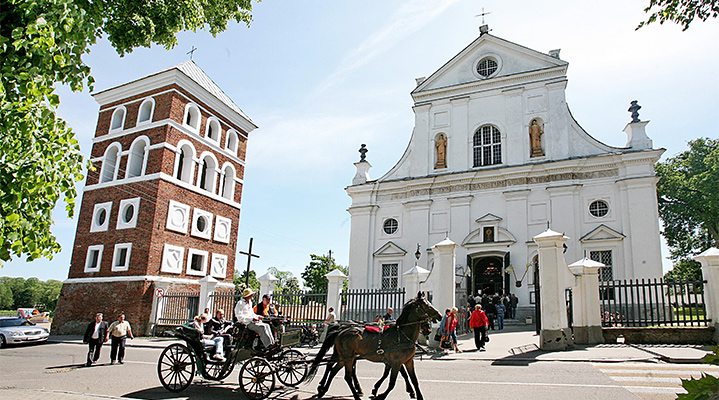 The 16th-century Castle Tower stands close to the Corpus Christi Church. Once it made part of a system of defensive walls around Nesvizh near the Castle Gate, today it is used as a bell tower. The massive four-tier structure was built from red brick and combines the elements of the Belarusian defense architecture, the Gothic and Renaissance architecture. The Arched windows, round and square openings, and solid ornamental elements and sections between the tiers are painted white and create a geometric pattern, contrasting with the red brick background.
The 16th-century Castle Tower stands close to the Corpus Christi Church. Once it made part of a system of defensive walls around Nesvizh near the Castle Gate, today it is used as a bell tower. The massive four-tier structure was built from red brick and combines the elements of the Belarusian defense architecture, the Gothic and Renaissance architecture. The Arched windows, round and square openings, and solid ornamental elements and sections between the tiers are painted white and create a geometric pattern, contrasting with the red brick background.
Monument to Symon Budny
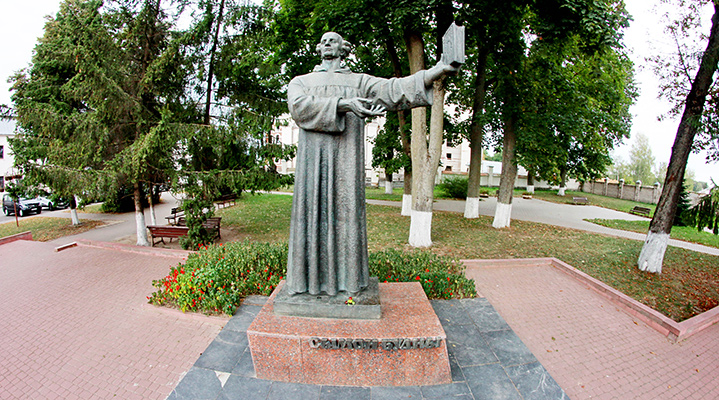 The life of Symon Budny, an outstanding figure in the Grand Duchy of Lithuania, a humanist, educator, philosopher, writer, and publicist, was also linked with the town of Nesvizh. In the early 1560s together with Matvei Kavechinsky and Lavrentiy Krishkovsky, he founded a printing house in Nesvizh. In 1562, Symon Budny printed the first book in the territory of Belarus – Cathechesis in the Old Belarusian language that was written in the question and answer format. His other books also saw the light of day in Nesvizh. In 1982, the descendants unveiled a monument to the famous humanist near the Corpus Christi Church as a token of their gratitude. The bronze sculpture of Symon Budny towers on a granite pedestal. The sculpture holds a book with an emblem of the sun – a symbol of light and knowledge.
The life of Symon Budny, an outstanding figure in the Grand Duchy of Lithuania, a humanist, educator, philosopher, writer, and publicist, was also linked with the town of Nesvizh. In the early 1560s together with Matvei Kavechinsky and Lavrentiy Krishkovsky, he founded a printing house in Nesvizh. In 1562, Symon Budny printed the first book in the territory of Belarus – Cathechesis in the Old Belarusian language that was written in the question and answer format. His other books also saw the light of day in Nesvizh. In 1982, the descendants unveiled a monument to the famous humanist near the Corpus Christi Church as a token of their gratitude. The bronze sculpture of Symon Budny towers on a granite pedestal. The sculpture holds a book with an emblem of the sun – a symbol of light and knowledge.
Slutsk Gate
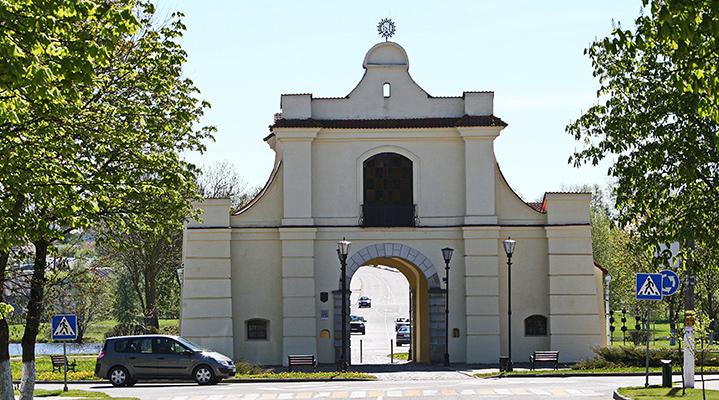 The gate is a unique structure of the baroque architecture in Belarus. It was built in the 16th century and still stands on the road between Nesvizh and the town of Slutsk. This gate is the only one out of five gates that were built as part of the Nesvizh defense system in the late 16th – early 17th centuries. The first floor of the gate featured rooms for guards and a tax collector. Everyone who entered the town were obliged to pay a tax. The second floor was allocated for a chapel of the Mother of God. At present, the gate is home to an exhibition that is open in the summer season.
The gate is a unique structure of the baroque architecture in Belarus. It was built in the 16th century and still stands on the road between Nesvizh and the town of Slutsk. This gate is the only one out of five gates that were built as part of the Nesvizh defense system in the late 16th – early 17th centuries. The first floor of the gate featured rooms for guards and a tax collector. Everyone who entered the town were obliged to pay a tax. The second floor was allocated for a chapel of the Mother of God. At present, the gate is home to an exhibition that is open in the summer season.
Nesvizh Town Hall
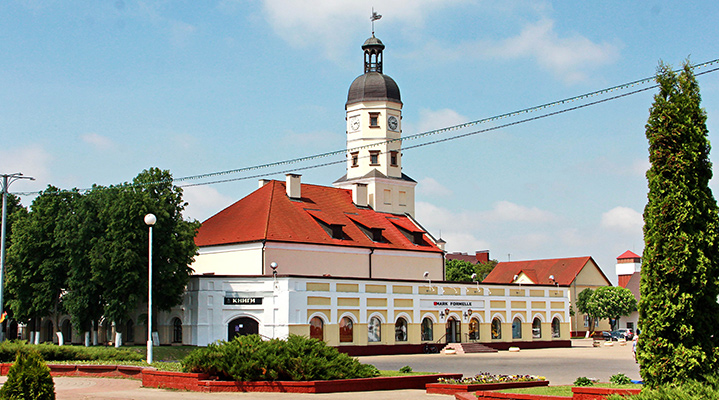 The Town Hall in Nesvizh is the oldest surviving magistrate building in Belarus. It was built in 1596 in ten years after the town was granted the Magdeburg Right and Prince Mikolaj Krzysztof Radziwill the Orphan passed the bill on the rights and duties of citizens. In accordance with the document, residents of Nesvizh were obliged to take part in the erection of town fortifications and to contribute the construction of the town hall financially. They say that the project was authored by renowned Italian architect Bernardoni: his building, rectangular in plan and baroque in style, was crowned by a six-tiered clock tower.
The Town Hall in Nesvizh is the oldest surviving magistrate building in Belarus. It was built in 1596 in ten years after the town was granted the Magdeburg Right and Prince Mikolaj Krzysztof Radziwill the Orphan passed the bill on the rights and duties of citizens. In accordance with the document, residents of Nesvizh were obliged to take part in the erection of town fortifications and to contribute the construction of the town hall financially. They say that the project was authored by renowned Italian architect Bernardoni: his building, rectangular in plan and baroque in style, was crowned by a six-tiered clock tower.
There was a scrivener’s office, a hall of records, a treasury, a weight house and rented shops on the ground floor; a magistrate’s conference hall and a courtroom on the first floor. Firefighting appliances and town guard ammunition were stored, a prison and a warders’ room were placed in the basement. The Town Hall was surrounded by shopping arcades.
The Town Hall was rebuilt, restored from fires and dilapidation several times in the course of history. After the Great Patriotic War, the building was used as a community center, a youth club, and a library. After the big renovation of 1997-2004, the Town Hall acquired its historic appearance and is now part of the museum reserve. The Town Hall houses an exposition featuring the history of Nesvizh self-government on the first floor; an education center and a cafe on the ground floor.
Artisan House or the House at the Marketplace
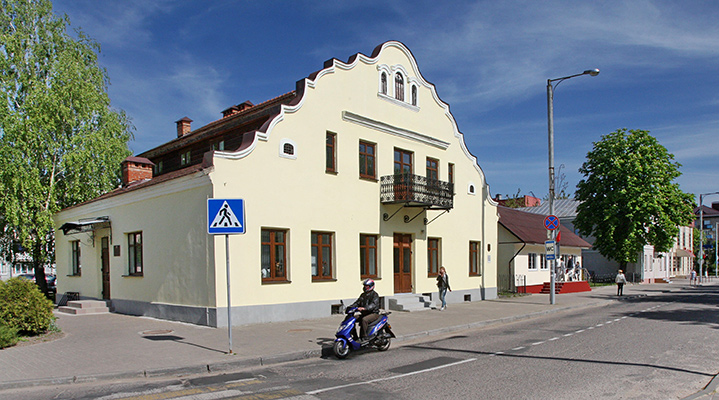 Just like in the days of old the remarkable Baroque-style stone house stands in the historical Marketplace Square. It was built in 1721 opposite the town hall. It is yet unclear whether an enterprising artisan or a merchant, who attracted other artisans, lived here. Only one thing is clear: he was definitely a well-off man. The first floor was occupied by warehouses and shops while living rooms were located on the second floor. At present this house is the only remaining example of urban homes with an unusual facade, which were popular in the first half of the 18th century.
Just like in the days of old the remarkable Baroque-style stone house stands in the historical Marketplace Square. It was built in 1721 opposite the town hall. It is yet unclear whether an enterprising artisan or a merchant, who attracted other artisans, lived here. Only one thing is clear: he was definitely a well-off man. The first floor was occupied by warehouses and shops while living rooms were located on the second floor. At present this house is the only remaining example of urban homes with an unusual facade, which were popular in the first half of the 18th century.
Nesvizh History and Local Lore Museum
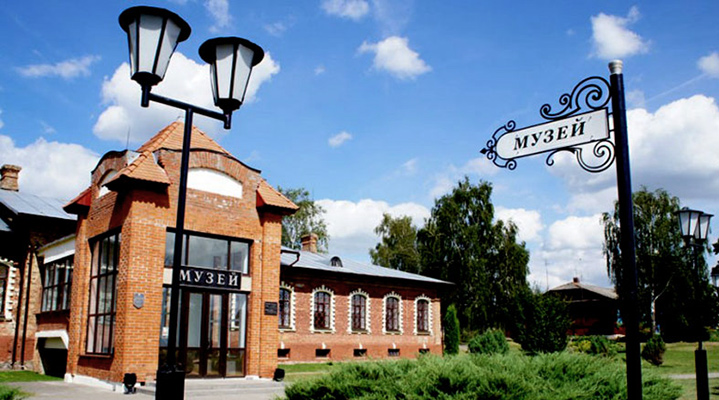 The Nesvizh museum is located in an old house built in the late 19th century. It was initially built for a tradesmen school and was repurposed later by the army. A museum was opened in 1995 in the restored building. At present it comprises several places – expositions relating to the local history and lore, an apartment-museum of the painter Mikhail Sevruk, a pottery workshop, and a blacksmith’s museum.
The Nesvizh museum is located in an old house built in the late 19th century. It was initially built for a tradesmen school and was repurposed later by the army. A museum was opened in 1995 in the restored building. At present it comprises several places – expositions relating to the local history and lore, an apartment-museum of the painter Mikhail Sevruk, a pottery workshop, and a blacksmith’s museum.
Benedictine Convent
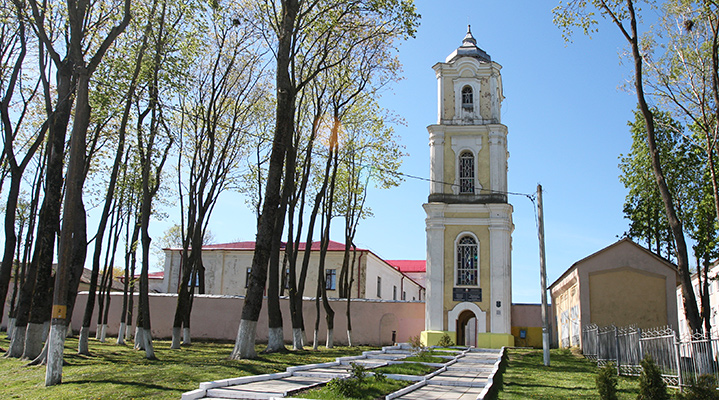 A Benedictine cloister, the first Catholic convent in Belarus, was erected in Nesvizh in 1593-1596. The project was sponsored by Prince Mikolaj Krzysztof Radziwill the Orphan and his spouse Elzbieta Eufemia. A complex of buildings with nunneries and a beautiful church featuring baroque and renaissance elements was designed by Giovanni Maria Bernardoni. The convent was also part of the town fortifications. It was surrounded by a grandiose Nesvizh bulwark and ditches with water from the Usha River.
A Benedictine cloister, the first Catholic convent in Belarus, was erected in Nesvizh in 1593-1596. The project was sponsored by Prince Mikolaj Krzysztof Radziwill the Orphan and his spouse Elzbieta Eufemia. A complex of buildings with nunneries and a beautiful church featuring baroque and renaissance elements was designed by Giovanni Maria Bernardoni. The convent was also part of the town fortifications. It was surrounded by a grandiose Nesvizh bulwark and ditches with water from the Usha River.
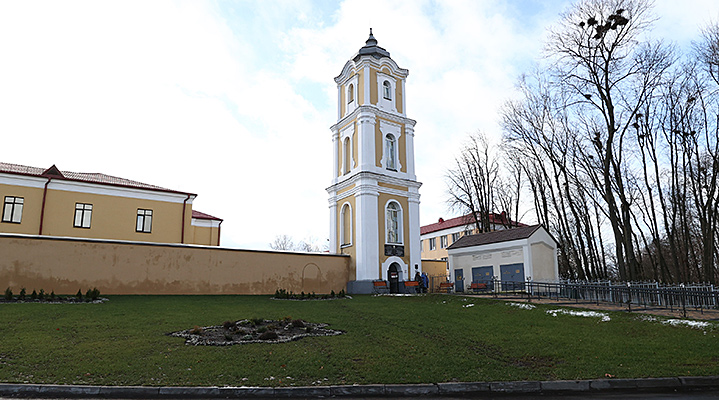
Centuries ago the Benedictine convent had a school for daughters of local nobility. It also had a music academy and a huge library. At the end of the 19th century St. Eufemia Church was rebuilt and turned into an Orthodox church, the convent ceased to exist, and its buildings were turned into soldiers’ barracks. For a short period of time in the 1920s the complex was returned to the Catholic church. Benedictine nuns opened a kindergarten, a primary school and a tailor’s school which existed till 1944. After the Great Patriotic War the building was used as a teaching college and boarding school till 1984. The teaching college is still based there. Not all authentic buildings have survived in the course of centuries, but visitors can see old buildings and the main sight – a three-tiered bell tower of the second half of the 18th century.
Lion as the town’s guardian
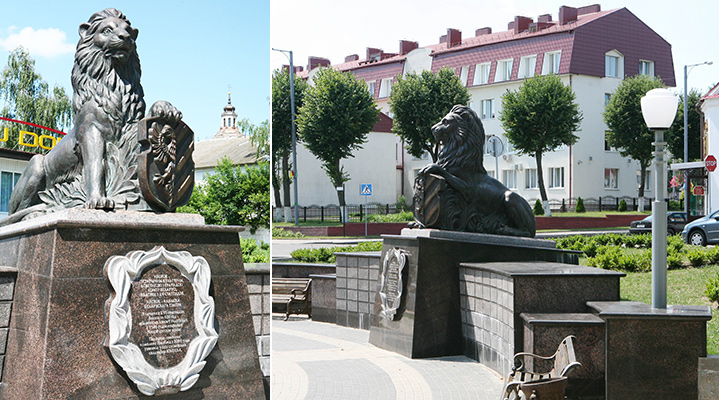 Sculptures of lions at entrances to cities, castles, palaces, and parks are a tradition that has existed in many cultures since ancient times. But the modern town guardian lion was added quite recently – in 2014. The authors were also inspired by the fact that the ex libris of the legendary Radziwill library bears the image of a lion, which holds a heraldic shield with a princely coat-of-arms in one paw. Thus, a new bronze lion “settled down” in a pocket park between Leninskaya Street, Slutskaya Street, and Chkalova Street where fortress defenses were located in the 16th – early 17th centuries. The lion has already become part of the town’s image.
Sculptures of lions at entrances to cities, castles, palaces, and parks are a tradition that has existed in many cultures since ancient times. But the modern town guardian lion was added quite recently – in 2014. The authors were also inspired by the fact that the ex libris of the legendary Radziwill library bears the image of a lion, which holds a heraldic shield with a princely coat-of-arms in one paw. Thus, a new bronze lion “settled down” in a pocket park between Leninskaya Street, Slutskaya Street, and Chkalova Street where fortress defenses were located in the 16th – early 17th centuries. The lion has already become part of the town’s image.
Alba Park
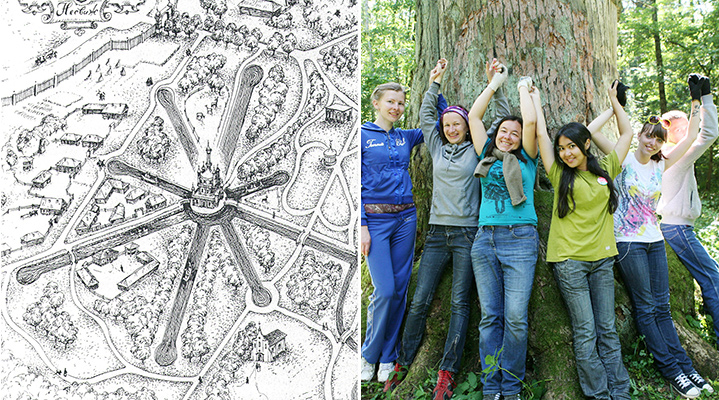 The ancient Alba Park is located far from the center of the town. Hundreds of years ago it was also part of the prince’s lands – a beautiful summer residence, a place for recreation and meditation for the princely family. Belarus’ first zoo was opened there. Multiple local animals and exotic ones were gathered in the zoo. The park fell on hard times as time went by but a gradual revival of this important place for Belarusian history has recently begun.
The ancient Alba Park is located far from the center of the town. Hundreds of years ago it was also part of the prince’s lands – a beautiful summer residence, a place for recreation and meditation for the princely family. Belarus’ first zoo was opened there. Multiple local animals and exotic ones were gathered in the zoo. The park fell on hard times as time went by but a gradual revival of this important place for Belarusian history has recently begun.
The place was a swamp in the past. The Radziwills ordered it drained – dikes were built, a system of six ponds was created, a round island surrounded by water and connected to land by five ray-like roads was built. A gazebo that resembled Hagia Sophia in Constantinople was built on the island. Small vessels were used to train the basics of sea navigation in the ponds.
Prince Mikolaj Krzysztof Radziwill the Orphan had an ermitarium erected as one of the first buildings in Alba Park. An ermitarium is a place for prayers and meditation. He would retire to the ermitarium himself. Whenever he left the residence, he would invite Jesuitical monks to keep praying there. On the whole, while the palace and the surrounding parks were designed for social life, for receiving guests and for entertainment, Alba Park was a spiritual place, a sacred place for the entire family.
Today cleanup days are held there. The drainage system is being cleaned up. Plans have been made to restore the lost buildings in Alba Park using authentic drawings and blueprints.


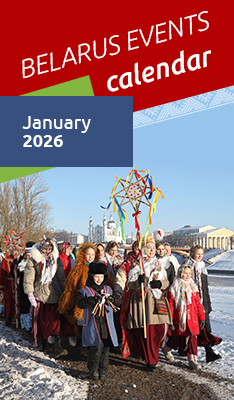




 print version
print version make home page
make home page add to bookmarks
add to bookmarks
